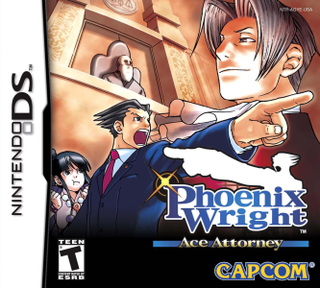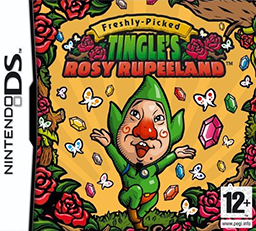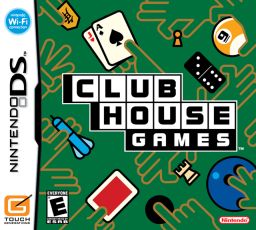
Balloon Fight is an action video game developed by Nintendo and HAL Laboratory and published by Nintendo. The original arcade version was released for the Nintendo VS. System internationally as Vs. Balloon Fight, while its Nintendo Entertainment System counterpart was released in Japan in 1985 and internationally in 1986.

Dragon Quest IV: Chapters of the Chosen, titled Dragon Warrior IV when initially localized to North America, is a role-playing video game, the fourth installment of the Dragon Quest video game series developed by Chunsoft and published by Enix, and the first of the Zenithian Trilogy. It was originally released for the Famicom on 11 February 1990 in Japan. A North American NES version followed in October 1992, and would be the last Dragon Quest game localized and published by Enix's Enix America Corporation subsidiary prior to its closure in November 1995, as well as the last Dragon Quest game to be localized into English prior to the localization of Dragon Warrior Monsters in December 1999. The game was remade by Heartbeat for the PlayStation, which eventually was available as an Ultimate Hits game. The remake was ported by ArtePiazza to the Nintendo DS, released in Japan November 2007 and worldwide in September 2008. A mobile version based on the Nintendo DS remake was released in 2014 for Android and iOS.

Super Mario 64 DS is a 2004 platform game developed and published by Nintendo for the Nintendo DS. It was a launch game for the DS. Super Mario 64 DS is a remake of the 1996 Nintendo 64 game Super Mario 64, with new graphics, characters, collectibles, a multiplayer mode, and several extra minigames. As with the original, the plot centers on rescuing Princess Peach from Bowser. Unlike the original, Yoshi is the first playable character, with Mario, Luigi, and Wario being unlockable characters in early phases of the game.

Giftpia, stylized as GiFTPiA, is a video game, developed by Skip Ltd. for the GameCube. It was released in Japan on April 25, 2003. Nintendo cancelled the North American localization of Giftpia. In English, the game would most likely be better understood as called "Giftopia" to represent the two words, gift and utopia.

Phoenix Wright: Ace Attorney is a visual novel adventure game developed and published by Capcom. It was released in 2001 for the Game Boy Advance in Japan and has been ported to multiple platforms. The 2005 Nintendo DS version, titled Gyakuten Saiban Yomigaeru Gyakuten in Japan, introduced an English language option, and was the first time the game was released in North America and Europe. It is the first entry in the Ace Attorney series; several sequels and spin-offs were produced, while this game has seen further ports and remasters for computers, game consoles, and mobile devices.

Final Fantasy Legend II, known in Japan as SaGa 2: Hihou Densetsu, is a role-playing video game developed and published by Square for the Game Boy. The second entry in the SaGa series, it was released in 1990 in Japan, and in 1991 in North America. A remake for the Nintendo DS was released in 2009 by Square Enix, remaining exclusive to Japan. The Game Boy version was later ported to the Nintendo Switch and released worldwide by Square Enix in 2020, with later ports to Android, iOS and Microsoft Windows in 2021.

Tingle is a recurring character in The Legend of Zelda series, designed by Takaya Imamura. He first appeared in Majora's Mask, where he is a 35-year-old map salesman who wants to become a fairy. He has since appeared in several installments, including The Wind Waker, where he provides maps to help Link find pieces of the Triforce. He has gone on to be the star of Freshly-Picked Tingle's Rosy Rupeeland, where his origin as Tingle is shown as him tasked with collecting as many Rupees as possible. He also appears in its sequel Irozuki Tingle no Koi no Balloon Trip, where he is transported into a storybook and has to enter into relationships with women in order to escape.

Freshly-Picked Tingle's Rosy Rupeeland is an adventure video game developed by Vanpool and published by Nintendo for the Nintendo DS handheld game console. It was released in Japan in September 2006, and in Europe in September 2007.

Clubhouse Games, known in some European countries as 42 All-Time Classics and in Japanese as Dare demo Asobi Taizen, is a compilation video game developed by Agenda and published by Nintendo for the Nintendo DS, consisting of board, card, and tabletop games from around the world. It was released in Japan on November 3, 2005, in Europe on September 29, 2006, in North America on October 9, 2006, and in Australia on October 26, 2006.

Pokémon Battle Revolution is a turn-based strategy video game in the Pokémon series developed by Genius Sonority and published by The Pokémon Company and Nintendo. It was released for the Wii on December 14, 2006, in Japan; on June 25, 2007, in North America; on November 22, 2007, in Australia, and on December 7, 2007, in Europe. Along with being the first Wii incarnation of the Pokémon video game franchise, it is also the first Wii game to use the Nintendo Wi-Fi Connection in North America and Japan and the second Wii game to wirelessly interact with the Nintendo DS handheld.

Vanpool, Inc. was an independent Japanese video game, music software, computer software and toy developer. Its employees included Taro Kudou and Kazuyuki Kurashima, both of whom worked for the independent game developer Love-de-Lic. The company shut down on May 31, 2023.

Final Fantasy Fables: Chocobo's Dungeon is a 2007 role-playing video game published by Square Enix for the Wii. It is an installment in the Chocobo series that focuses on Chocobo and his quest to free a town lost in time from eternal forgetfulness. It is a loose sequel to Chocobo's Dungeon 2 on the PlayStation.

Mario Kart Wii is a 2008 kart racing game developed and published by Nintendo for the Wii. It is the sixth installment in the Mario Kart series, and was released in April 2008. Like its previous installments, Mario Kart Wii incorporates playable characters from the Mario series, who participate in races on 32 different race tracks using specialized items to hinder opponents or gain advantages. The game features multiple single-player and multiplayer game modes including two to four person split screen. Online multiplayer was supported until the discontinuation of Nintendo Wi-Fi Connection in May 2014. Mario Kart Wii uses the Wii Remote's motion-controls to provide intuitive and conventional steering controls. Each copy of the game was bundled with the Wii Wheel accessory to augment this feature and mimic a steering wheel.

Kingdom Hearts 358/2 Days is an action role-playing video game developed by h.a.n.d. and Square Enix in collaboration with Disney Interactive Studios for the Nintendo DS. It is the fifth installment in the Kingdom Hearts series, and takes place near the end of the first game in parallel to Kingdom Hearts: Chain of Memories, leading directly into the events of Kingdom Hearts II. The game was released worldwide in 2009. The story is told from the perspective of Roxas, and follows his daily life within Organization XIII and his relationship with fellow Organization member Axel; it also introduces a fourteenth member, Xion, who befriends them.

The Wizard of Oz: Beyond the Yellow Brick Road, known in Japan as Riz-Zoawd, is a role-playing video game developed by Japanese developer Media.Vision for the Nintendo DS. The game is an adaptation of L. Frank Baum's 1900 novel The Wonderful Wizard of Oz, using its characters, locations and plot. The game was originally published in Japan by D3 Publisher on December 25, 2008. Xseed Games published the game in North America on September 29, 2009.

Blood of Bahamut is an action role-playing video game developed by Think & Feel and published by Square Enix. It was released for the Nintendo DS in Japan on August 6, 2009.

Tomodachi Collection,, is a social simulation video game for the Nintendo DS, released in Japan on June 18, 2009. A sequel, Tomodachi Life, was released for the Nintendo 3DS in Japan on April 18, 2013, and in North America and Europe on June 6, 2014.
Cattle Call Inc. is a Japanese game developer based in Tokyo, Japan. The company was established by former staff of Data East Corporation and is engaged in developing original console games as well as co-developing and porting games for other game companies.

















